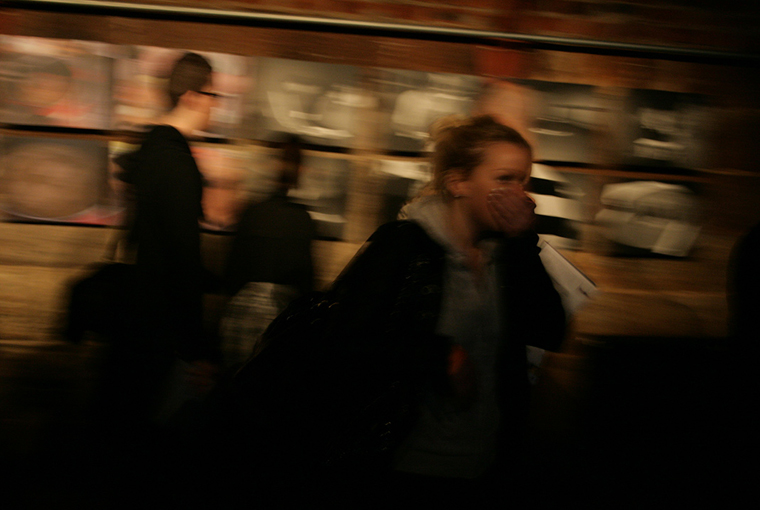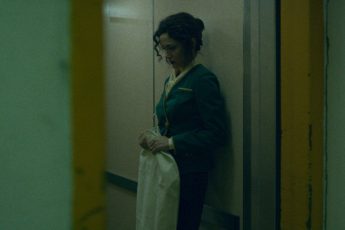Satire and Cynicism
The Video and Performance Art of Zoran Todorović
Vol. 26 (February 2013) by Konstanty Kuzma
Zoran Todorović, born in 1965 in Belgrade, is a Serbian video and performance artist. Todorović graduated from the Faculty of Fine Arts in Belgrade where he’s been holding a teaching position since 2006. Though few Balkan artists have had international success on the scale that Marina Abramović has (indeed, few artists have), he has enjoyed considerable exposure through solo and group exhibitions around the world, including shows at the Belgrade Museum of Contemporary Arts and the Centre Pompidou. Todorović doesn’t belong to the youngest generation of Serbian or Balkan artists either, but his inclusion in the Serbian Pavilion at the 53rd Biennale (2009) confirmed that his work is still deemed contemporary and relevant enough to represent and shock internationally.
One of the most shrewd works of Todorović is Assimilation, a typically provocative performance work in which visitors consume leftovers from the human body removed during plastic surgery. A plate with the human jelly is offered to visitors and – in parallel – ”anatomised” by photo series or video recordings documenting the surgery. Hence, the audience is constantly confronted with the origin of their meal: the performance is based on constant visual affect, not a mere factual informing. That these two approaches vary greatly in their effect is a reason for the immense success of Super Size Me, a film that was stylistically indistinguishable from other mainstream pseudo-investigative films and provided viewers with few hard facts, let alone new information. In spite of this one-dimensionality, the visual analysis of the effects of fast food consumption made it unexpectedly attractive. In the end, the film stirred up wide-reaching debates, ultimately even forcing changes in the policies of leading U.S. fast food chains.
In capitalism (take fast food as an example), the alienation of assembly and production from the final product is virtually complete: we don’t know, and often don’t want to know, how a product we consume was produced. In fact, it is inefficient for markets to be reliant on informed consumers, and, conversely, inefficient for consumers to be reliant on markets that meet strict normative standards. This is why markets are so slow at meeting consumers’ moral standards, and why the latter are so painfully lax to begin with: economically, being fair doesn’t pay off. Hence, in capitalism ignorance of the form Todorović confronts us with is in fact productive, which should reflect in his experiment, too: one would expect the visual documentation of the plastic surgery to dis-encourage people from consuming the unappetizing meal. However, Todorović’s critique does not seem to be directed at capitalism concretely; for that, it is both too abstract and too local. Too abstract because rather than explicitly attacking a system or an ideology, Todorović is primarily interested in the concept of “biopolitics”; and too local because Todorović seems to be interested in challenging the “micropolitics” of his environment rather than the wider socio-economic picture.
The concept of biopolitics, in this instance originating in Foucault’s work, describes the infliction of governance on the human body. Originally, this mainly entailed the major disciplinary practices as described in Foucault’s Discipline and Punish or Madness and Civilization, but postmodern theoreticians soon extended its scope to serve wider ideological ends (to their credit, biopolitics is indeed a fairly flexible term). In Todorović’s work, then, biopolitics refers to the problematic integration and assimilation of our anatomy in society. As Miško Šuvaković notes,1 this theme is also recognizable in Bite, another performance-photograph hybrid in which a nude woman hangs on a hook attached to a wall, her entire body weight being supported by her mouth. The woman on the photograph is an Eastern European prostitute, a not-so-minor detail that brings up the question over political corectness again. Todorović’s work features many of such emulative constellations, in which the flaws, crimes and misdemeanors of society are integrated into his exhibits. Under the banner of art, Todorović thus mimics society to uncover its sickness. Šuvaković calls this provocative technique “therapy,” but there is also a satirical moment to it.
Firstly, like satire (and, in this case, therapy), Todorović is in large part interested in covering up the flaws of society. Though his early work features some ideologically “neutral” works (e.g. Untachibles from 1992-1994, a modular structure), his oeuvre is dominated by a drive to open the eyes of his audience about important topics. Secondly, many of his works share a comic effect. This is most visible in Laughter, a performance work in which gallery spaces are filled with nitrous oxide (“laughter-gas”), but Agalma (a variation on the Assimilation idea, in which food is replaced with soap), Assimilation, Bite and Noise are bound to provoke similarly nervous reactions. Who’d be surprised to find people amused about the undesirable human products presented in Agalma and Assimilation; the “absurd and exhibitionistic play – “naked-body-effort-floating-hanging-endurance””2 from Bite; or the curious behavior of certain individuals subjected under various modes of Foucaultian oppression (i.e. Noise, in which three groups of people – ordinary pedestrians, patients in a psychiatric clinic, and prisoners – record messages into an especially designed device for video messages)? Finally, like satire, in his depiction of our society’s malady, Todorović draws upon exaggeration consistently (e.g. Assimilation), an indispensable stylistic mean to his cause (critique, after all, always consists of a certain form of exaggerated symptomatisation).
The problem with satire is its proximity to cynicism, a far sterner cousin. While Todorović’s pursuit for truth is laudable, it can grow tiresome over time. Todorović seems to treat micro-political scandals and political incorrectness as quasi-justificatory terms and preconditions to inducing meaning in performance and video art – a dangerous stance. Just as a certain class of politically correct Eastern European films seems to be prefabricated for the Western festival circuit and EU bureaucrats, so Todorović’s work often appears to be designed to exploit political incorrectness. But what entails dependence on vectors of political correctness for the former also entails that same dependence for the latter. Ironically, both the most and least servile films are thus tied to the same moral system, the former by trying to appeal to it, the latter by countering it. For Todorović’s work, that is an unfortunate pattern, and a possible reason for a qualitative stagnation in his latest work.
Warmth – a recent work which was showcased at the Biennale 2009 – combines some of Todorović’s main ideas in a grand-scale installation. The Serbian artist claims to have taken the hair of approximately 240 000 people to create folded blankets – couches, one could say – with which people can interfere (touch, watch, smell) while videos document their transportation and processing from hairdresser’s stool to finished exhibit. In this case, too, Todorović didn’t miss the opportunity to reference the techniques of disciplinary society – apart from regular salons, the hair also originates from prisons and military barracks where cutting hair is part of a disciplinary mechanism. This “DNA map of the ‘Serbian nation’” (notice the inverted commas around ”Serbian nation”), as Branislav Dimitrijevic argues, could potentially be used to identify any of the people who donated their hair to the exhibit, the blankets thus serving as both a semantic and a non-semantic object:
The amassed blankets are objects at the borderline between functionalism and symbolism yet fatally undermining both of these forms of representation and meaning-production.3
This sentence, if we do treat it as meaningful at all, highlights another problem of Todorović’s art: the status of meaning. Because video and performance art are less reliant on emotions and narratives than cinema is, they are more committed to meaning than the latter. Where film directors commonly dismiss interpretative questions to preserve a certain degree of semantic gray area, video and performance artists are usually keen to take part in academically tainted discussions of their work. But that need not establish a semantic consensus. In Todorović’s case, his postmodern self-awareness and magic words like “biopolitics” are supposed to make the split between disciplinary and biopolitical attitudes of our society on the one hand, and their meaningful treatment in his art on the other. But Warmth doesn’t convey any of that – it’s a provocative installation and a creative one, but its connection to some of the problems Todorović hopes to address is questionable. It’s only thanks to Todorović’s other works (in essence, Warmth reiterates what Agalma and Assimilation already uttered) and its extensive theoretical fundament that proper meaning is bestowed on this work. Meaning in video art can be parasitic, dependent on the readiness of viewers to inform themselves, and of critics to support it. But the question is how lax we want to be with meaning: since art will always lack the rigid tools of linguistic analysis (luckily so), it is upon film makers and viewers to judge what a certain piece or film “means”. In this case, I think that over-interpretation has caused some confusion.




Leave a Comment